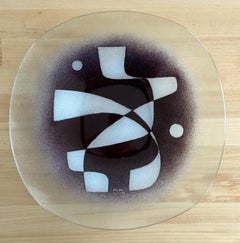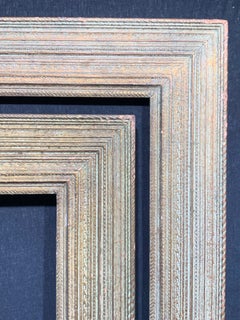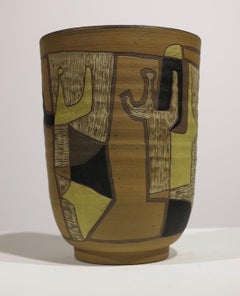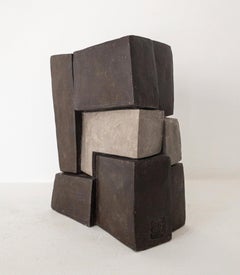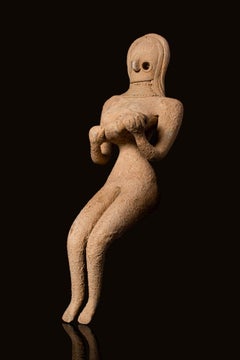FOMOBOY More Art
to
3
4
1
Overall Width
to
Overall Height
to
1
4
1
1
2
4
1
3
1
1
1
1
1
5
Brutalist Ceramic Abstract Expressionist Lamp Base or Vase Form
Located in Wilton Manors, FL
Raymond Gallucci (1923-2005)
Lamp Base, ca. 1970.
Glazed ceramic. 15 " h, 7 3/8" w, 6" d.
Opening for lamp post measures 11/16 inch.
While the piece would make a lovely lamp, we...
Category
1970s Abstract Expressionist More Art
Materials
Ceramic
Geometric abstract glass dish
Located in Wilton Manors, FL
Plate is in perfect condition. and measures 1.75 x 9.75 x 9.75 inches.
Category
Mid-20th Century Abstract Geometric More Art
Materials
Glass
Stanford White Newcomb-Macklin picture frame pair
By Stanford White
Located in Wilton Manors, FL
PERIOD FRAMES c. 1915 American painting frame pair, (earlier Stanford White design), Newcomb-Macklin, New York makers, gold leaf, gray bole, gesso, on c...
Category
Early 20th Century Aesthetic Movement More Art
Materials
Gold Leaf
$1,800 Sale Price
70% Off
Chimu Inca c.1500 Peruvian terra-cotta anthropomorphic face vase vessel Peru
Located in Wilton Manors, FL
Beautiful antique Peruvian face vessel. Chimu Inca, c.1500 Terracotta, measures h. 8 in., w. 4 7/8 inches. No repair or conservation.
Category
15th Century and Earlier More Art
Materials
Terracotta
$720 Sale Price
60% Off
Vase
By Leonard Edmondson
Located in Wilton Manors, FL
Leonard Waegell Edmondson (1916-2002). Ceramic with sgraffito and fired opaque polychrome. 6.5 inches tall. 4.5 inches circumference. Excellent condition with no damage or restoratio...
Category
1950s Cubist More Art
Materials
Ceramic
$2,800 Sale Price
20% Off
Related Items
Unity II by Delphine Brabant - Abstract geometric sculpture, terracotta, brown
By Delphine Brabant
Located in Paris, FR
Unity II is a unique terracotta sculpture by contemporary artist Delphine Brabant, dimensions are 26 × 19 × 12 cm (10.2 × 7.5 × 4.7 in).
The sculpture is signed and comes with a cer...
Category
2010s Contemporary Abstract Sculptures
Materials
Terracotta
$4,547
H 10.24 in W 7.49 in D 4.73 in
Mother Goddess Figurine, Early Indus Valley Civilization (circa 3500 - 2800 BC)
Located in Paris, Île-de-France
Mother Goddess Figurine
Early Indus Valley Civilization (circa 3500 - 2800 BC)
Handmade pottery, 140 mm x 45 mm, 60 g
Provenance:
Prince Collection, 1990s-2014;
Pierre Bergé Colle...
Category
15th Century and Earlier Tribal Nude Sculptures
Materials
Clay, Terracotta
$5,196 Sale Price
41% Off
H 5.52 in W 1.78 in D 0.79 in
Dialog , 100x140 cm, acrylic on canvas
By Tatiana Nega
Located in Yerevan, AM
Dialog, 2023, 100x140 cm
Category
2010s Abstract Geometric Abstract Paintings
Materials
Acrylic
$2,250 Sale Price
25% Off
H 39.38 in W 55.12 in
Solar Imp
By Helen Frankenthaler
Located in New York, NY
Screenprint in colors on wove paper. Signed by the artist in pencil and also numbered 96/126 in pencil. Published by Lincoln Center List Poster and Print Program, New York.
Second ...
Category
Early 2000s Abstract Expressionist Abstract Prints
Materials
Screen, Color
Rare Palestine Antique Hebrew Judaica Yahrzeit Synagogue Sign Memorial Plaque
Located in Surfside, FL
Circa 1890-1920. This Neoclassical, Judaic, Egyptian revival, Orientalist Mizrach sign, was produced in British Mandate Palestine by the chromolithograph process at the beginning of the 20th century. It pictures vignettes of holy places. with a hand written memorial. It was for the Tzedakah charity fund for the century-old institutions in Jerusalem: The great "Torah Center Etz Chaim"; a Free Kitchen for poor children and orphans; the famous Bikur Cholim Hospital with its dispensaries and clinics and the only Home for Incurable Invalids in Eretz Israel. They also worked with Arthur Szyk and Alfred Salzmann.. The A.L. Monsohn Lithographic Press (Monzon Press, Monson Press, דפוס אבן א"ל מאנזאהן, דפוס מונזון) was established in Jerusalem in 1892 by Abraham-Leib (or Avrom-Leyb) Monsohn II (Jerusalem, c.1871-1930) and his brother Moshe-Mordechai (Meyshe-Mordkhe). Sponsored by members of the Hamburger family, the brothers had been sent to Frankfurt, Germany in 1890 to study lithography. Upon returning to Jerusalem in 1892 with a hand press, they established the A.L. Monsohn Lithographic Press in the Old City of Jerusalem. According to the Information Center for Israeli Art A.L. Monsohn "created complex decorations for documents and oriental calendars that combined the tradition of Jewish art with modern printing techniques such as photographic lithography, raised printing and gilding."
The founders of the Monsohn press produced Jewish-themed color postcards, greeting cards, Jewish National Fund stamps, and maps documenting the evolution of the Jewish settlement in Eretz Israel in the nineteenth-twentieth centuries; religious material such as decorative plaques for synagogues, portraits of Old Yishuv rabbis such as Shmuel Salant, Mizrah posters indicating the direction of prayer for synagogues, memorial posters, and posters for Sukkot booths; color frontispieces for books such as Pentateuch volumes and the early song collections of Abraham Zvi Idelsohn (e.g., Shire Zion, Jerusalem 1908); artistic wedding invitations; and labels, packaging and advertisements for the pioneering entrepreneurs of Eretz Israel. The texts appearing in the Monsohn products were in several languages: Hebrew, Arabic, Yiddish, English, German (e.g., a c1920 trilingual Hebrew-English-Arabic "Malaria Danger" broadside warning the public of mosquitoes spreading malaria). Many of the brilliantly colored postcards and maps can be seen online as can the artistic invitations to his children's weddings which Monsohn published in the Jerusalem Hebrew press.
For years, the Monsohn (later, Monson/Monzon) Press was considered the best and most innovative in the country—pioneering in such techniques as gold-embossing and offset printing, among others. Early items for tourists included collections of Flowers of the Holy Land (c. 1910–1918)—pressed local flowers accompanied by scenes from the Eretz Israel countryside and relevant verses from the Bible, edited by Jsac Chagise (or Itzhak Haggis), an immigrant from Vitebsk, and bound in carved olive wood boards. Shortly after World War I Monsohn (now spelled מונזון) used zincography to produce the prints included in the Hebrew Gannenu educational booklets for young children illustrated by Ze'ev Raban of the Bezalel Academy of Art and Design and printed in Jerusalem by Hayim Refael Hakohen (vol. 1, 1919; vols. 2–3, 1920). In 1934 Monsohn moved into the new, western part of Jerusalem, in a shop with four presses and 30 workers, including Abraham-Leib's sons, David, Yosef, Moshe and Shimon, and his daughter Raytse's husband, Abraham Barmacz. The concern did business with all sectors of the city's population, including Arabs, for whom they printed in Arabic. Among their clients were members of the Ginio, Havilio, and Elite families, and Shemen, Dubek, and other renowned national brands, manufacturing products such as wine, candies, oil, and cigarettes. They also printed movie and travel posters, and government posters, postcards and documents, hotel luggage labels...
Category
Early 20th Century Aesthetic Movement More Art
Materials
Lithograph
Indian Art Pottery Buddha Large Charger Swans Flowers Art India 19th Century
Located in Norfolk, GB
A fabulous and rare large 19th century Bombay Pottery Charger from the J J School of Art, depicting scenes of Buddha from the Ajanta caves.
Bombay Scho...
Category
1870s Other Art Style More Art
Materials
Clay, Terracotta, Paint, Glaze
$5,148
H 1.78 in Dm 17.92 in
An Ancient Style Greek Black Figure Calyx Krater, 19th/20th Century
Located in Beachwood, OH
Ancient Style Greek Black Figure Calyx Krater, 19th/20th Century
Terracotta
17 x 14.5 inches
A calyx krater is a type of ancient Greek pottery, specifically a type of krater (a bowl...
Category
Late 19th Century More Art
Materials
Terracotta
Kunsttöpferei Kandern, Thrown vase with double gradient glaze / - Flowering vase
Located in Berlin, DE
Kunsttöpferei Kandern (1897-1927), Thrown vase with two layers of glaze, between 1914 and 1927, terracotta, marked 'KTK' on the underside and marked as model number '781', 19 cm (hei...
Category
1920s Art Nouveau More Art
Materials
Terracotta
$170 Sale Price
20% Off
H 3.94 in W 5.12 in
Kunsttöpferei Kandern, Bulbous vase with gradient glaze / - Inner abundance -
Located in Berlin, DE
Kunsttöpferei Kandern (1897-1927), Bulbous vase with clay-colored gradient glaze on a black-blue ground, between 1914 and 1927. Terracotta, marked 'KTK' on the underside and identifi...
Category
1920s Art Nouveau More Art
Materials
Terracotta
$274 Sale Price
20% Off
H 19 in W 12 in
Acrobat (detail), Limited Edition Porcelain Plate in bespoke gift box - Abstract
By Helen Frankenthaler
Located in New York, NY
This porcelain/ceramic plate makes a gorgeous gift - in a bright blue bespoke box, ready to be gifted. Any fan of Helen Frankenthaler or Abstract Expressionist art would be thrilled!...
Category
2010s Abstract Expressionist More Art
Materials
Porcelain, Screen, Cardboard, Mixed Media
Enormous Greek Apulian Red Figure Lekythos, 19th/20th Century
Located in Beachwood, OH
Enormous Greek Apulian Red Figure Lekythos, 19th/20th Century
Terracotta
41 x 15 inches
This has been mended and is showing numerous cracks.
A lek...
Category
Early 20th Century More Art
Materials
Terracotta
Sam Gilliam Handmade Paper "Untitled #34" Acrylic. Signed & Dated
By Sam Gilliam
Located in Detroit, MI
“Untitled #34” was created by Sam Gilliam, one of the great innovators in postwar American painting. It is dated and signed on the lower front. The thick handmade paper is rich with folds and texture and the colors lively. In addition to Acrylic paint on the surface there appears to be imbedded color in the handmade paper which has additional embossed accents. Unframed the piece measures 16 x 14. Provenance of Yaw Gallery, Birmingham, Michigan is on the verso along with the note that the Paper Surfaces in contact with this artwork are acid free.
In the mid-1960s he emerged from the Washington D.C. scene with works that elaborated upon and disrupted the ethos of Color School painting. A series of formal breakthroughs would soon result in his canonical Drape paintings, which expanded upon the tenets of Abstract Expressionism in entirely new ways. One profound manner was the sculpture aspect of the painting giving it a free flowing expression of pure color.
In the latter half of the 1950s, Washington D.C. saw a flourishing of abstract art that emphasized the form-making capabilities of pure color. Known as The Washington Color School, the loosely affiliated group of abstract painters knew each other through various teaching experiences. The moniker has an uncertain origin but likely originated with the title of a 1965 exhibition at the Washington Gallery of Modern Art, "Washington Color Painters," curated by Gerald Nordland. The show exhibited the works of Kenneth Noland, Paul Reed, Morris Louis, Howard Mehring, Thomas Downing, and Gene Davis. Additionally, Leon Berkowitz...
Category
1970s Abstract Expressionist Abstract Paintings
Materials
Acrylic, Handmade Paper
$12,000
H 20.75 in W 19.75 in
